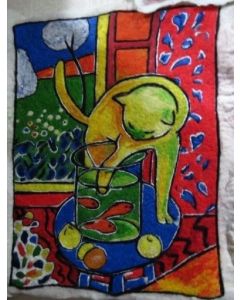FELTED WOOL CRAFT
FELTED WOOL CRAFT
Felt - wool blanket “kecha”, made in few Georgian Regions:Tusheti, Kakheti, Khevi and Javakheti. Shepherds and herdsmen used felt to cover their tents centuries ago.
Felt is one of the oldest methods of creating and processing fabric and is a heritage of Georgian folk art. The production of this fabric and its artistic processing has occupied a great place in the cultural, aesthetic and economic development of Georgia since ancient times. Archaeological excavations and records of ancient historians, geographers and travelers (Herodotus, Strabo, later Marco Polo, Chardin) testify to the fact that in ancient Georgia there was a fabric obtained from the processing of raw materials - wool.
These historians also provide information on the mountainous regions of Georgia, where the main source of livelihood of the population was livestock on the wool fabric, in particular felt. The Caucasus, and Georgia in particular, as the center of ancient civilization, has preserved and passed on to the next generation the remnants of ancient culture, which confirms its close connection with the Middle East and Sumerian-Babylonian civilizations. The color expression and harmony of these patterns are special. It is characterized by deep and natural colors. Ornamental paintings are also characteristic, many of them date back to the archaic era. Felt production in Georgia started from the time when people mastered the technique of processing them. This is how carpets, rugs, clothes, hats, shoes, Georgian Chokha-Nabadi made of felt were born. The processing of felt and wool, reflecting the family tradition and way of life of folk handicrafts, was passed down from generation to generation. Every woman in the family should know wool processing techniques, dyeing, weaving, and creating art back in time.
The family craft institute was organized in such a way that labor was distributed equally among all family members, studies in families started at an early age.
The color palette created by the ancestors is still an example of harmony today. The source of inspiration for contemporary artists and masters is often folk handicrafts. By understanding and studying past masters and rich historical examples, future generations create new patterns of felt fabric based on their own tastes and talents. In contemporary art, the renaissance of old mastery is re-emerging, gaining new artistic value.
Felt fabric is also used for the treatment of various diseases due to its 100% natural wool composition. Wool contains the active substance - lanolin, which protects it from external pollution.
It is known for its positive effects in the treatment of rheumatism, arthritis, sciatica, lumbar and spine pain, in the treatment of hemorrhoids and lymphadenitis. It is characterized by good air permeability and a sense of comfort.
It neutralizes toxic substances from the human body and protects the human body from electromagnetic fields. Felt fabric made of non-dyed wool has the most beneficial properties.


Comments
Post a Comment